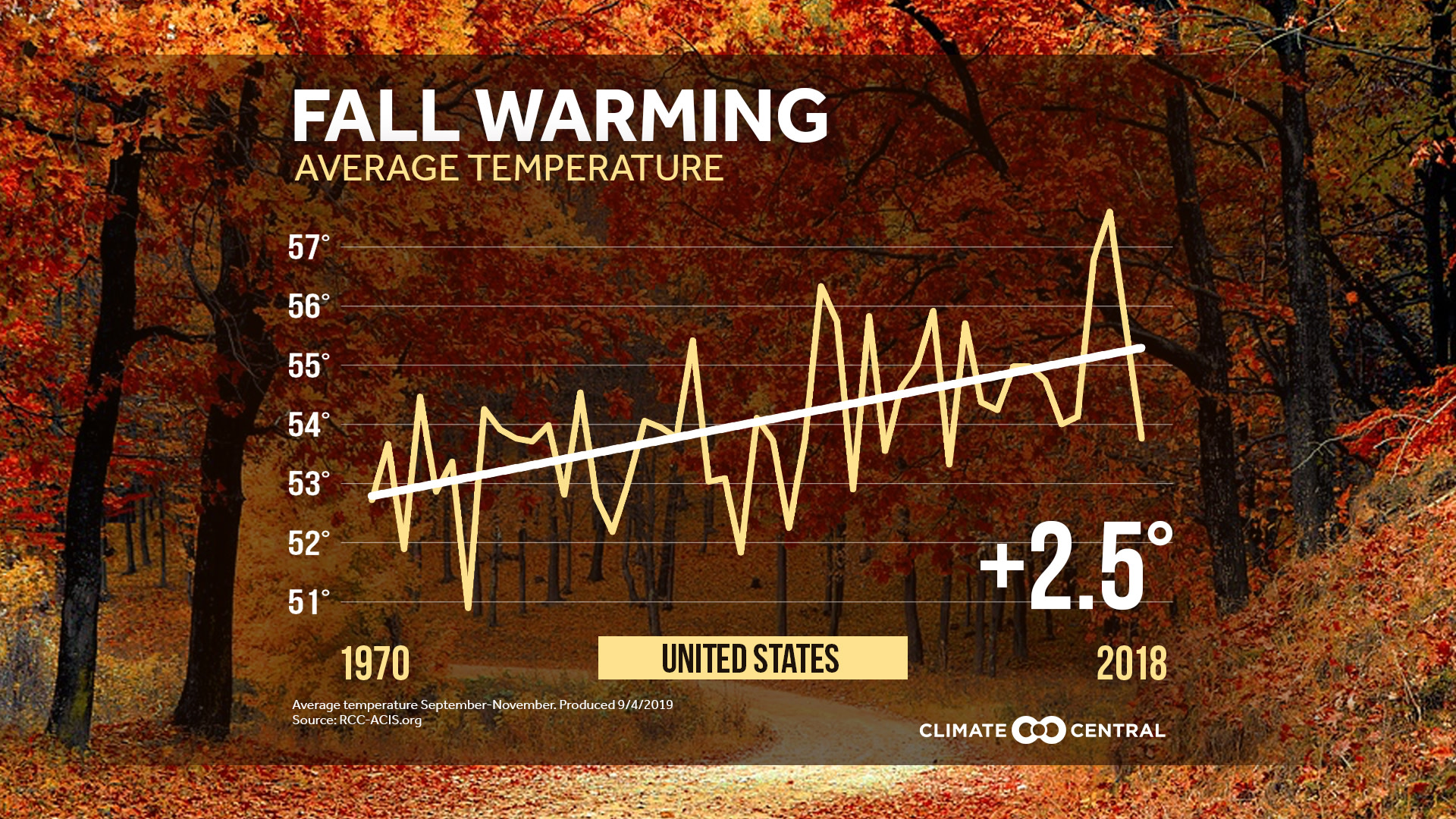Across the United States, the fall season is getting warmer, with longer allergy and mosquito seasons, and impacts on agriculture and energy demand.
Local Fall Trends 2019
KEY CONCEPTS
Climate Central analysis shows that autumn in the contiguous U.S. has warmed by an average of 2.5 degrees since 1970.
Of the 244 U.S. cities analyzed, 95% recorded an increase in fall temperatures—with more than half experiencing a rise of 2°F or more.
Fall is getting warmer across the United States, impacting harvests and crops, lengthening the allergy and mosquito seasons, and adding to energy demand for cooling.
DOWNLOAD DATA
WHAT YOU NEED TO KNOW
Climate Central analyzed average fall temperatures (September through November) for 244 U.S. cities, going back to 1970. Results showed that 229 cities had an increase.
Among the 244 cities analyzed, the seven highest increases were in the western U.S.:
CityAverage °F IncreaseReno, Nev7.7Las Vegas5.9El Paso, Texas5.4Phoenix5.1Tucson, Ariz.5.1Helena, Mont.4.8Las Cruces, N.M.4.8Burlington, Vt.4.3Minneapolis4.2Presque Isle, Maine4.2
With summer conditions stretching further into the meteorological fall season, a number of impacts are being felt:
Energy demands for cooling remain high for longer (which adds to air conditioning costs)
Ecosystems are impacted, including bird migration, hibernation and fruit ripening
POTENTIAL STORY ANGLES
How will a warmer fall affect the crops and harvests in your region?
The 2018 National Climate Assessment discusses challenges faced by our agricultural system and rural communities due to climate change. A warming climate can mean lower crop yields and more crop pests, and increased uncertainty around fruit production, including for apples and wine grapes.
What does a longer pollen season mean for allergy sufferers near you?
With studies showing climate change likely already contributing to longer pollen seasons and increased levels in pollen, the fall ragweed season can be especially unhealthy for some. The Asthma and Allergy Foundation of America (AAFA) has a fall allergy capital report listing of locations around the country ranking cities by the highest counts for pollen, allergy medicine use, and the number of allergy specialists.
LOCAL INTERVIEW SUGGESTIONS
Talk to a local farmer: the USDA maintains directories for farmers and community-supported agriculture (CSA) in your area--just type in your zip code.
The Asthma and Allergy Foundation of America (AAFA) can connect you to local medical professionals concerning the fall allergy season and conducts annual rankings of allergy “capitals” around the U.S.
The Audubon Society has 23 state programs and more than 450 local chapters where you can find out about how local birds are impacted by climate change.
The SciLine service,500 Women Scientists or the press offices of local universities may be able to connect you with biologists and scientists to discuss climate change impacts on local biodiversity and ecosystems.
NATIONAL INTERVIEW SUGGESTIONS
Amanda Gallinat
Postdoctoral Researcher in the Pearse Lab
Utah State University
Department of Biology & Ecology Center
Can Discuss: Climate change and evolutionary ecology
Lead Author, Autumn, the Neglected Season in Climate Change Research
Curtis Deutsch
Associate Professor, Oceanography
University of Washington
College of the Environment
Can discuss: Interactions between climate and ecosystems; biodiversity
Lead author: Increase in crop losses to insect pests in a warming climate
Kenneth Mendez
President and CEO
Asthma and Allergy Foundation of America (AAFA)
Can discuss: Longer allergy season
Interviews arranged by press officer at media@aafa.org
HOW WE GOT THE DATA
The national trend in fall temperatures are fromNOAA/NCEI Climate at a Glance for September through November. Individual city temperature trends are calculated using data from the Applied Climate Information System for the same period. Displayed trend lines on city analyses are based on a mathematical linear regression.
Climate Central's local analyses include 244 stations. However, for data summaries based on linear trends, only 242 stations are included due to large data gaps in St. Johnsbury, Vermont and Wheeling, West Virginia.
YOUR LOCAL DATA
To download data on temperatures from all 244 weather stations analyzed, click here.
